Leaving a beautiful place and its people with heavy hearts
It’s with great sadness that we announce our departure from the Cape Verde islands.
We left an anchorage in the deserted island of Santa Luzia on the 04/01 at 15 :30 UTC. Santa Luzia is located between the island of Sao Nicolau and Sao Vicente, it has a wonderful white sandy beach that extends over a few kilometres, lots of fishes but the lobsters are a bit more shy this season.
But let’s start from the beginning. As you know we left Toulon, France mid-November and ended up in Gibraltar. Sophie was seasick most of the passage. We had a bit of rest in Gibraltar, enjoyed it’s UK climate and filled the tanks with rainwater in no time !
We then departed Gibraltar and headed for the Canaries islands -again Sophie spewed overboard and was completely unwell for 4 days out of 5. I must say we had just over 24hrs close hauled, which means beating into 30 knot winds with the sea-state that goes with it.
The kids had absolutely no issues getting used to whatever was thrown at them and behaved extremely well, playing together, reading books and sleeping lots.
Upon arrival to the Canaries Islands, we explored Gran Canaria, then Tenerife and last but not least, La Gomera which was very pretty, wild, green and has some gorgeous hikes.
We then left the Canaries for another 4 ½ days at sea to reach Cape Verde, you must have guessed it, Sophie was crook again for 4 days… She decided to take some tablets before leaving the Canaries but she forgot and it was too late once she started vomiting endlessly.
Cape Verde was fantastic as well, although we had mixed reports about the archipelago, the people we met were very friendly, helpful and always smiling. We met a few other sailboats with kids there and we soon called the group of 4 boats “the village “. We followed each other between islands and explored new environments together.
We met a local fisherman who was hitchhiking from the island of Sal to the island of Sao Nicolau to spend Christmas with his mum. He and his girlfriend ended up spending 3 nights with us and it was very nice to have them aboard to say the least. As they knew the area, they took us to some places where we wouldn’t have gone by ourselves, met other locals and spent a lot of time trying to communicate. The official language of Cape Verde is Portuguese but everybody speaks Creole. Our new guests speak more Creole than Portuguese, not that it bothers us as our Portuguese level is nothing more than speaking Spanish with a few extra “sh sh” sounds every now and then, which probably sounds more funny than have an actual meaning. We use a lot of gestures, some drawing and pictures in books to communicate, it works actually quite well and we end up having interesting conversations. Francesco lives off spearfishing. His diving equipment is constituted of a patched up mask, a wetsuit with numerous holes and 2 different fins that have been repaired several times, his speargun is very old and has seen better days but everything is functional and he is happy with what he’s got.
We spent a few mornings and afternoons underwater, while he taught me the art of his job. We brought back lots of very tasty fishes that his girlfriend Eloïsa cooked for us. He also speared a large parrotfish, he prepares it differently with lots of salt and lets it dry on our bowsprit for 2 days. Eloisa and him offered to buy all the necessary ingredients and cook it onboard for Christmas. Three different anchorages later and we end up in Tarrafal where we drop them off on the 24/12.
We spend Xmas on Kapa Rico with another catamaran alongside, 13 adults on KR and 12 kids on the other cat. Everyone made something different to eat and we share the feast with Francesco, Eloisa and another local who joined us as well. Everything was delicious including the dried/salted fish Eloisa cooked.
The following days we are all invited to Francesco’s mum’s house for an afternoon tea with all the kids. The house is very simple, no fridge or freezer, just a 44gallon drum inside a room with a sink and another room with a bed and home made bedside table. The drum is padlocked and it contents flour, rice and some valuables. The kitchen is outside, a few sticks of firewood and dried up donkey’s poo on the side as fuel for the fire, a large aluminium pot over hot coals with something boiling inside. There is a small fire in the corner of this kitchen made of a few wooden poles and a rusted up sheet of corrugated iron as roof. Francesco’s mum, Antonia is a lovely lady, Eloisa and her prepared some popcorn, pork crackle and juice for the kids. The adults drink a home made liquor and local rum. A few neighbours join the party without an invite to check out the unusual guests and have a chat and bring some old school loudspeakers with some Cape Verde tunes. It was so cool !
Francesco’s brother, Filich, is also a fisherman but he fishes for tuna and mahi mahi. We organise to go with him for a day to see how it’s done locally.
Day One ;catch the bait ! Filich picks me and Charly up on a very colourful 6m wooden skiff with a 9.9hp outboard. We travel about 1 hour and meet another 2 skiffs, they are all the same boats, just different colours. One of them has a net onboard and the 3rd one carries a large round cage with fine nets all around and floats on top. Everybody jumps on the boat that has the net and we are all equipped with masks and fins. 3 divers jump in the water and start searching for the bait. One of the divers waves at the boat and everyone including me jumps off and start rounding up the school of little black fishes with swallow tails they call Kakao. I know of a similar species from the Mediterranean with the latin name of “chromis chromis” if you want to look it up and see what it looks like. Thee only difference is an additional small yellow spot at the base of the tail . Filich coordinates the net deployment by a series of signs and some yelling through his snorkel. The boat races around us as it dumps the net in a circle around the school of Kakaos, it’s about 6-7m deep, the net has floats at the top and weights at the bottom. The kakao are now surrounded by a thin meshed wall but it doesn’t seem to bother them too much – I don’t think they realise what’s going on! The 2 remaining guys on the boat start pulling the bottom of the net upon Filich’ distinctive snorkel bark. As they pull, the divers untangle the bottom of the net that gets stuck on the rocks as it’s getting dragged, I’m part of them and it’s quite exciting to go up and down as fast as possible to untangle the net and try to reduce the amount of kakaos escaping through the holes and gaps in the net. Once the net almost all in the boat, the school of fish is carefully caught with a butterfly net and dumped into the live bait tank of the boat. This operation is repeated 3 times and the live fishes are placed into the round floating cage and left overnight.
Filich picks me and another guy up at 4:50am the following day, departure was planned for 4am but what’s 50minutes between friends ? We then go to the spot where we left the kakaos chilling overnight and met the 2 other boats there. We share the catch between us and there is some left overs for the following day. We have about 2000 Kakaos onboard and I keep wondering why have we caught so many ?? We are 4 onboard, Filich, his mate Elvis who is hungover, Geoffrey from the other catamaran and I. We motor West for about 30minutes until we are not sheltered from the island anymore, Elvis spew overboard which makes Filich laugh. Elvis then proceeds to put a pole in a hole on the deck and rigs up a sail. It’s actually a green tarp you could get from Bunnings cut to shape and with a small reinforcement rope hand sewn all around. The tarp is rolled on a bamboo pole which gets hoisted to the top of the mast. Filich grabs a rope and adjust the tension of the squill. The outboard is shut down, removed, placed on the side and replaced by a rudder. We are now sailing this little wooden boat, it has no keel, there is about a 15-20 knots wind, 1.5 to 2 metre waves, about 20cm freeboard and all that prevents us prom tipping over is the skilled helmsman and everybody sitting on the leeward side. Luckily , Filich warned us the day before and we are all wearing our wet weather gear, we are soaking wet. We are quite surprised to see the speed on a tablet with navionics app I brought with us (alongside with a lifejacket and an EPIRB just in case) we are doing about 6.5 to7 knots and more surfing down waves. About 2 hours later we arrive at the spot, they don’t have any GPS or fish finder, they use the shapes of the mountains on the island of Razo and Sao Nicolau to know where they are. Elvis pulls out an anchor made of reo bars welded together, there is about 3 different ropes knotted together that get dumped over the side too. A few other boats join us and we are about 50m from each other. Filich opens the lid where the kakao are swimming and catches about 10 of them and places them into a bucket full of water, he then throws 3 or 4 of them into the water, about 10m from the boat, followed by a 5th one that he carefully placed a hook in its back, a 10 meter monofilament 100lbs leader line attached to 3mm rope neatly coiled up into a bucket, I guess there is about 300m of line in each bucket. I understand now why we needed so much bait, only a handful actually get a hook, the other ones are just thrown in the water to bring the tuna in and create a feeding frenzy. A few seconds later, the first fish, a 2kg bonito, gets a big bang on its head before being thrown on the deck. Elvis follows the same process at a slower pace due to the large amount of rum he had last night. We end up catching 9 tunas between 5 and 7 kilos and 6 bonitos.
We sailed back to Tarrafal, got wet again. Upon arrival to our respective boat, Filich gives us a tuna each and doesn’t want anything in return, I offer to fill up their fuel tank and they carry on to the port to sell their catch. A Tuna is sold for 200 Escudos per kilo, 150 for a kilo of Bonito. The boat and the outboard doesn’t belong to them either, they “hire” the boat for 2000 Escudos and another 2000 Escudos for the outboard, the fuel is on top. If they catch nothing, they pay nothing and make up for it another day. The fishes that are not sold to the locals are sold a bit cheaper to a small factory that makes canned tuna and exports it. Filich tells us with a big smile on his face that they only put Bonito in it most of the time.
This was such a unique, amazing and awesome experience! One I shall hold dear for the rest of my life.
The following day Filich passes by our boat to show us his catch of the day, Elvis was too hungover that day so he went by himself. He caught 2X 80kg tunas and a few smaller ones and tells us his personal best was 120kg this season.
A couple of days later we pass by Francesco’s and Filich mum’s house to drop off a memory stick with photos of them and us, they don’t have a computer but they have a friend who has one and there is a local shop that can print pictures.
We tell Francesco we are on our way to the mountain for a hike with the kids and buy some veggies for the trans-Atlantic passage. He offers to join us which we accept of course.
We jump on the back of a ute, they call them Aluguers, they are like taxis, and head for the mountain, there is only one road so we can’t really get lost.
Tarrafal is quite dry and rocky but as soon we gain some altitude , everything gets much greener, there are corn, banana and papaya plantations everywhere.
We hop off the Aluguer and pay 240 Escudos for 3, kids are free, we walk down the road, admire the landscape and the friendliness of the locals. Francesco doesn’t usually come to the mountain, he asks around where is the best place to buy fruit and veggies. We end up in front of a house and can see all the plantations and greenhouses at the back. Manuel greets us and informs us that he can’t help us today as it’s Sunday and his workers are not there, we decide to come back the following day and hike Monte Gordo with Francesco. It’s his first time there, the scenery is stunning and there are wild cherry tomatoes everywhere, Francesco picks some fruits and nuts along the way that are all unknown to us but very tasty ! He carries Amelia on his shoulders most of the way up and she walks the way back down.
Francesco and I went back up the mountain to buy the fruit and veggies, Manuel already prepared some carrots, potatoes, tomatoes and green bananas still attached together as per our request. Who said bananas on a boat are bad luck ? We now have 25 kg of them !!!
I ask Manuel for lettuce and parsley, he tells me to follow him, we walk through about 50m of sugar cane and arrive at a large green house. We kick our boots and dust off our clothes before entering through 2 doors with fly screens to keep the bugs out. Tomatoes, cucumbers, lettuce… it’s all there, nice and clean and no chemicals in sight. I get my 4 lettuces and as we leave the green house, I notice some eggplants. Manuel picks the 5 that are ready and we carry on, a few lemons, parsley and beetroots pulled out of the earth before my eyes and we are done. Before leaving, Manuel wants us to try his home made rum, it’s so tasty that I buy a litre of it, he puts about 1.5 litres of the precious alcohol in an empty 5 litre water bottle. His wife gives us a handful of passion fruits as a gift and we are on our way.
We borrow a wheel barrow to carry our precious load to the road and wait for an aluguer to drive by, load it all in and get driven back to the Port of Tarrafal.
Eloisa is waiting for us with 2kg of coffee beans that Francesco’s mum made herself . They help us carrying our veggies into our dinghy and onto the boat, we exchanged some presents and said goodbye. We were all quite emotional as we all knew we might never see each other again, Amelia was quite attached to Eloisa, they both cried and so did Sophie.
After cleaning and packing up the boat we left for the island of Santa Luzia where the other 3 boats were waiting for us to party for New Year’s Eve.
A couple of days later of spearfishing, building sand castles on the beach and doing a lot of relaxing, we depart Cape Verde and are now crossing the Atlantic Ocean.
3rd day into it and we have already travelled 510 nautical miles with an average speed of 7.9 knots. We are under spinnaker pretty much from the start and the boat is loving it, flying on top of the waves often around 10-12knots with a top speed at 18.2 knots surfing down a wave this morning!
The spinnaker stays up day and night and we will only take it down if we see a squall on the radar (so far blue skies all around) or if the apparent wind speed increases above 20 knots – which is far from being the case as we average 12 to 15 knots apparent at AWA120° so far.
We broke our record of distance traveled in 24hours today. Exactly 200miles and it’s extremely comfortable. Kapa Rico is such a great, fast, comfortable and safe boat, we couldn’t be happier. At this speed it should take us another 10days more or less.
Sophie took half of a Stugeron tablet the day we left and she hasn’t been seasick at all, she made bread, brioche, some delicious fish meals and even Papaya ice-cream!
She can even do her share of night watches which allows me to have a decent rest unlike during the previous passages.
The kids are loving it. Charly is learning to read and write but he prefers making drawings of boats and fishes for some reason. Amelia is, as usual, eating and sleeping a lot.
Life is nothing but good.

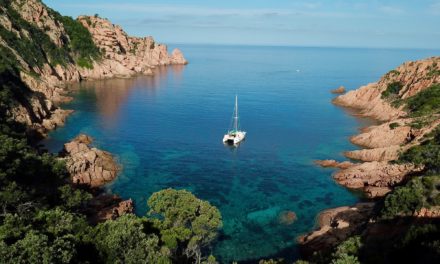

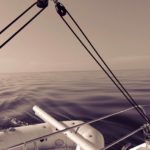
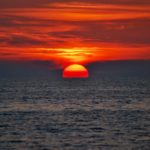
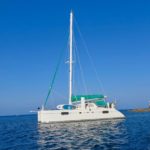
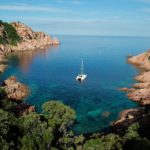
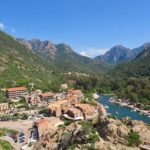
Comments